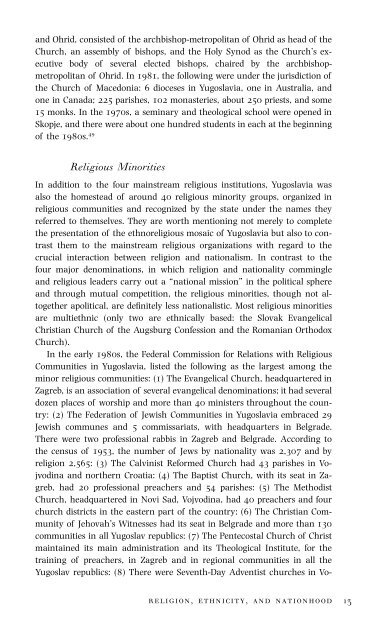Balkan Idols: Religion and Nationalism in Yugoslav States
Balkan Idols: Religion and Nationalism in Yugoslav States
Balkan Idols: Religion and Nationalism in Yugoslav States
You also want an ePaper? Increase the reach of your titles
YUMPU automatically turns print PDFs into web optimized ePapers that Google loves.
<strong>and</strong> Ohrid, consisted of the archbishop-metropolitan of Ohrid as head of the<br />
Church, an assembly of bishops, <strong>and</strong> the Holy Synod as the Church’s executive<br />
body of several elected bishops, chaired by the archbishopmetropolitan<br />
of Ohrid. In 1981, the follow<strong>in</strong>g were under the jurisdiction of<br />
the Church of Macedonia: 6 dioceses <strong>in</strong> <strong>Yugoslav</strong>ia, one <strong>in</strong> Australia, <strong>and</strong><br />
one <strong>in</strong> Canada; 225 parishes, 102 monasteries, about 250 priests, <strong>and</strong> some<br />
15 monks. In the 1970s, a sem<strong>in</strong>ary <strong>and</strong> theological school were opened <strong>in</strong><br />
Skopje, <strong>and</strong> there were about one hundred students <strong>in</strong> each at the beg<strong>in</strong>n<strong>in</strong>g<br />
of the 1980s. 49<br />
Religious M<strong>in</strong>orities<br />
In addition to the four ma<strong>in</strong>stream religious <strong>in</strong>stitutions, <strong>Yugoslav</strong>ia was<br />
also the homestead of around 40 religious m<strong>in</strong>ority groups, organized <strong>in</strong><br />
religious communities <strong>and</strong> recognized by the state under the names they<br />
referred to themselves. They are worth mention<strong>in</strong>g not merely to complete<br />
the presentation of the ethnoreligious mosaic of <strong>Yugoslav</strong>ia but also to contrast<br />
them to the ma<strong>in</strong>stream religious organizations with regard to the<br />
crucial <strong>in</strong>teraction between religion <strong>and</strong> nationalism. In contrast to the<br />
four major denom<strong>in</strong>ations, <strong>in</strong> which religion <strong>and</strong> nationality comm<strong>in</strong>gle<br />
<strong>and</strong> religious leaders carry out a “national mission” <strong>in</strong> the political sphere<br />
<strong>and</strong> through mutual competition, the religious m<strong>in</strong>orities, though not altogether<br />
apolitical, are def<strong>in</strong>itely less nationalistic. Most religious m<strong>in</strong>orities<br />
are multiethnic (only two are ethnically based: the Slovak Evangelical<br />
Christian Church of the Augsburg Confession <strong>and</strong> the Romanian Orthodox<br />
Church).<br />
In the early 1980s, the Federal Commission for Relations with Religious<br />
Communities <strong>in</strong> <strong>Yugoslav</strong>ia, listed the follow<strong>in</strong>g as the largest among the<br />
m<strong>in</strong>or religious communities: (1) The Evangelical Church, headquartered <strong>in</strong><br />
Zagreb, is an association of several evangelical denom<strong>in</strong>ations; it had several<br />
dozen places of worship <strong>and</strong> more than 40 m<strong>in</strong>isters throughout the country:<br />
(2) The Federation of Jewish Communities <strong>in</strong> <strong>Yugoslav</strong>ia embraced 29<br />
Jewish communes <strong>and</strong> 5 commissariats, with headquarters <strong>in</strong> Belgrade.<br />
There were two professional rabbis <strong>in</strong> Zagreb <strong>and</strong> Belgrade. Accord<strong>in</strong>g to<br />
the census of 1953, the number of Jews by nationality was 2,307 <strong>and</strong> by<br />
religion 2,565: (3) The Calv<strong>in</strong>ist Reformed Church had 43 parishes <strong>in</strong> Vojvod<strong>in</strong>a<br />
<strong>and</strong> northern Croatia: (4) The Baptist Church, with its seat <strong>in</strong> Zagreb,<br />
had 20 professional preachers <strong>and</strong> 54 parishes: (5) The Methodist<br />
Church, headquartered <strong>in</strong> Novi Sad, Vojvod<strong>in</strong>a, had 40 preachers <strong>and</strong> four<br />
church districts <strong>in</strong> the eastern part of the country: (6) The Christian Community<br />
of Jehovah’s Witnesses had its seat <strong>in</strong> Belgrade <strong>and</strong> more than 130<br />
communities <strong>in</strong> all <strong>Yugoslav</strong> republics: (7) The Pentecostal Church of Christ<br />
ma<strong>in</strong>ta<strong>in</strong>ed its ma<strong>in</strong> adm<strong>in</strong>istration <strong>and</strong> its Theological Institute, for the<br />
tra<strong>in</strong><strong>in</strong>g of preachers, <strong>in</strong> Zagreb <strong>and</strong> <strong>in</strong> regional communities <strong>in</strong> all the<br />
<strong>Yugoslav</strong> republics: (8) There were Seventh-Day Adventist churches <strong>in</strong> Vo-<br />
religion, ethnicity, <strong>and</strong> nationhood 13


